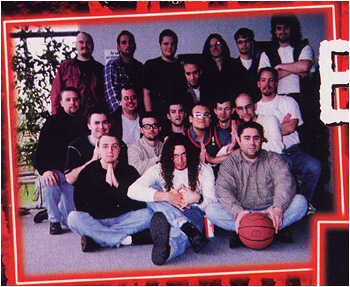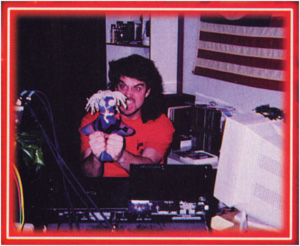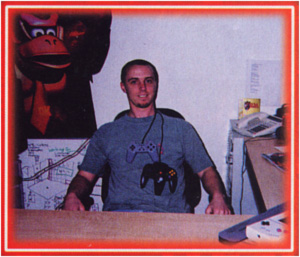(this section is under construction)
Lobotomy
Software Exposed...(GameFan Magazine)
The creators of PowerSlave return with Saturn conversions
of the biggest corridor shooters in existence! And we were there...
Unless you're a clued-in Saturn owner of a die-hard corridor fan, chances
are you;v never heard of Lobotomy Software. But all that is about to change.
In one fell swoop, Lobotomy has risen from the relative obscurity of coding
multimedia titles for Microsoft to become one of the most highly regarded
Saturn developers in the USA, entrusted with the not insignificant responsibility
of converting both Duke Nukem 3D and Quake to Sega's dark horse. The reason?
A game named PowerSlave.
In 1993 a group of friends working for Nintendo of America quit their
jobs to start their own company: Lobotomy. Initially working out of co-founder
Paul Lange's apartment, they soon found local office space in Redmond,
Seattle, and began work on a number of demos that eventually led to their
first major in-house project, a PC first person shooter originally called
Ruins, now known as PowerSlave.
PowerSlave on the PC was a straightforward "Doom" clone with an Egyptian theme that utilized the same graphics engine as Duke Nukem 3D(3D Realms' Build engine). PC PowerSlave was great fun, and helped Lobotomy secure a contract with Playmates for both a PS and Saturn conversion.
Initially, Lobotomy wanted to port PC PowerSlave over to the consoles with little or no changes, but thankfully the size and complexity of the PC levels made this impossible. So the Lobotomy design team, lead by creative director and co-founder Brian McNeely, went back to the drawing board and re-designed PowerSlave from scratch to incorporate new level design and a unique action/adventure structure that would later prove to be the game's greatest asset.
For a number of reasons(mainly that there were no decent corridor games on Saturn at that time), Lobotomy started work on the Saturn version of PowerSlave first, and with the help of lead programmer Ezra Dreisbach's stunning graphics engine(called Slave Driver!) they proceeded to create a superlative first person shooter that to this day has not been bettered as a one player corridor experience.
Next came PS PowerSlave,(or "PowerSlave Remix" as designer Dominick Meissner calls it), which benefited from some nice new graphical effects(check out the water and lighting), slightly tweaked level design and a very smooth engine courtesy of lead PS programmer Jeff Blazier. Both versions of PowerSlave are utterly superb, and fans of the genre should hunt them down NOW!
PowerSlave understandable caused quite a stir in the industry, particularly the Saturn version which single-handedly put the Saturn on the map as a platform for corridor shooters. So when Sega secured the rights from GT to publish the two greatest PC corridor games in existence on Saturn(Duke Nukem 3D and Quake) there was really only one choice of developer, right? Er, wrong.
As ridiculous as it may sound, Lobotomy wasn't Sega's first choice. For starters, SOA had actually turned down PowerSlave when they were offered it a while earlier(er, riiigght). Then, once they had obtained the rights for Duke and Quake from GT(who also overlooked Lobotomy), Sega farmed the games out to two other developers who initial efforts were, shall we say, "less than impressive"(they shall remain nameless). It was about this time that the specialist press started raving over PowerSlave, and Sega finally saw the light and approached Lobotomy at the end of '96.
Currently
Lobotomy is working on both games, with the companies 20-or-so staff split
roughly down the middle on each project. They have a number of games on
the back burner, including PowerSlave 2(a 3rd person Tomb Raider style
adventure staring a young King Ramses), Aquaria(like Nights underwater,
but with full 3D control) and a PC strategy game called Gothic. They are
currently in the process of applying to become and N64 developer(Aquaria
will be their first N64 title) and never miss the opportunity to snatch
a quick game of Death Tank during lunch breaks. Anyway, enough about Lobotomy.
Turn the page and check out the games you fools!
PowerSlave impressed us so much we sought out the game’s creators, Lobotomy Software, for a quick one on one. Under the spotlight are project leader Brian McNeely and Saturn lead programmer Ezra Dreisbach.
GF: Tell us a bit about Lobotomy’s background?
BM: Paul Lange, Dane Emerson, Scott Perras and myself quit our jobs at Nintendo of America about four years ago to start Lobotomy. We worked out of Paul’s apartment for a few months before finding some local office space. With the help of Kevin Chung and Paul Knutzen, we started working on a SNES demo, a boxing game similar to PunchOut!! Although the game was never picked up by a publisher, it helped us get our feet in the door. After a couple of years of more demos, CES shows and Top Ramen, we started working on an Egyptian first person PC game that was originally called Ruins, now known as PowerSlave. The development of this game eventually led to Saturn and PlayStation PowerSlave contracts.
GF: How many staff do you currently have working?
BM: There are currently 21 unique individuals working at Lobotomy.
GF: How many games have you made?
BM: We worked on a few products with Microsoft, but PowerSlave is our first original title developed completely in house.
GF: Why did you decide your first major game would be a first-person perspective shooter?
BM: We had a lot of ideas for this genre that we thought would be refreshing for gamers, and when we realized that Saturn gamers were in need of a great first-person adventure game, we jumped at the chance to provide them with one.
GF: What were your influences for PowerSlave, both in terms of theme and gameplay?
BM: We watched a bunch of Egyptian documentaries on the big screen in our break room and checked out stacks of Egyptian books from the local library. We did a lot of homework and brainstorming to ensure the authenticity of the theme. As far as gameplay goes, I guess you could say that that part of the development just came naturally. Between all of use we have seen several lifetimes of devoted gaming experience under our belts!
GF: What part of the game did you develop first?
BM: As work began on the 3D engine, our art and design teams began putting the framework of the game together on paper. We devoted a few weeks to this until we were happy with all of our concepts. At the same time, David Lawson began modifying and adding new features to BREW, our world editing tool. Paul Schrieber created a tool called Peepshow that we used to set up all the animations in the game, and Jeff Blazier developed an editor for object placement and ambient lighting. When all of these elements were ready, we started putting it all together to make a game.
GF: Most of the other corridor games, particularly on Saturn, seem to run very slowly in comparison with PowerSlave. Was it tricky to keep the speed and framerate so high?
ED: The other Saturn corridor games are either ports or Robotica! Writing a fast corridor game on the Saturn isn’t more tricky than writing on the PC. People just haven’t put much effort into it.
GF: PoweSlave’s engine allows for true 3D level design-rooms above rooms-something with Doom and Hexen did not. How difficult was this to implement?
ED: A full 3D engine is a better match for the Saturn hardware than a strip engine like Doom. I don’t think you could make a Doom-style engine that runs as fast as PowerSlave on the Saturn.
GF: The lighting effects in PowerSlave are exceptional, particularly on the Saturn. How were these achieved?
ED: I put the dynamic lights in after seeing Loaded on the PlayStation. Each of the wall polygons is being drawn gouraud shaded for the static torch light. As each vertex is transformed, the lighting contribution from the dynamic lights is added in. The algorithm is the cheapest, fastest thing I could think of that would still look okay.
GF: There are a number of differences between the PS and Saturn versions of PowerSlave, most notably level design and the Team Doll locations. Why the differences?
BM: We had to rebuild some stage areas on the PlayStation to cater to the differences in the game engines. During this process we decided to hide on Lobotomy Team Doll in every stage, unlike the Saturn version where the player might find two Dolls in one stage and no Dolls in another.
GF: At what stage in development did you choose to add the Team Dolls, and how long did it take to hide them all?
BM: Scott Branston, our sound engineer, discovered the Bomb-Boost trick while testing the Saturn version. When we were almost finished with the Saturn version, Dominick Meissner, Jeff Blazier and myself came up with the idea to hide the Team Dolls in secret places that forced the player to use the Bomb-Boost trick and other obscure techniques to uncover them. We had to move fast to get the secret areas into the game, so Dominick, Ezra and myself did about two months’ work in one week. During this completion time we only slept for an accumulated few hours during an entire week’s time, never leaving the office and sleeping under our desks! It was completely insane! When it was all over, after having been awake for nearly three straight days, we collapsed on the floor, laughing hysterically for days at what we had just done! Soon after, Ezra threw together Death Tank and we put it in the game as a reward for finding all the Dolls.
GF: PowerSlave is a game that beats its competition in all but one area: multiplayer action. Why did you choose not to include a link-up mode in either version?
ED: When we began development on Saturn PowerSlave there was no Sega link-cable or modem, so we didn’t really consider the issue. A multiplayer mode is very difficult to retrofit onto a game, so by the time the hardware materialized, it was too late.
GF: The sound in PowerSlave is among the best I’ve heard on any system. Who is responsible for the music and effects?
BM: Scott Branston is responsible for all the audio in the game. He has a passion for games and an ear for perfection. His secret? Lots of coffee and little sleep!
GF: Who’s the guy who did the voice over for the intro and King Ramses voice? He sure sounds familiar.
BM: His name is Don LaFontaine and his voice is used in several entertainment mediums. I don’t think a day goes by without hearing his voice on the radio or TV or on a movie trailer. He’s everywhere. Our US publisher, Playmates Interactive, hired him to do the voice sequences for PowerSlave.
GF: Is there anything that you would liked to have improved in the game had you had more time?
ED: I would have liked to have worked more on the monster AI.
GF: Can we expect to see a sequel to PowerSlave at some point? If so, what kind of new features would you like to incorporate?
BM: We are considering a sequel but don’t have any information about it right now.
GF: What do you guys think of the N64?
BM: The N64 has provided us with some very memorable gaming experiences. We’re excited about the future of the system and are really looking forward to games like StarFox and Zelda. What we’ve seen so far on the N64 has inspired and motivated us to develop a great game of our own on the system.
GF: Will you developing games for N64 in the future? An N64 version of PowerSlave perhaps?
BM: We are looking to develop a game for the N64 sometime in the near future, and we have several original concepts that could potentially take full advantage of the system.
GF: What plans do you have for future games after all version of PowerSlave and Duke Nukem 3D have shipped?
BM: We have started focusing heavily on new gaming possibilities with the idea that there is much room for improvement in many areas of game development. Undoubtedly, we will continue to develop great games that are industry-competitive and most importantly, fun for gamers!
GF: Thanks for your time guys, and keep up the good work!

Front Row:
Brian, Troy, William
Second Row:
Tom, Paul Knutzen, Kevin
Third Row:
Eric, John, Dominick, Pat, Paul Lange
Back Row:
Paul Haugerud, John Van Deusen, Jeff, David, Paul Schreiber, Scott
Scott Branston


Brian McNeely